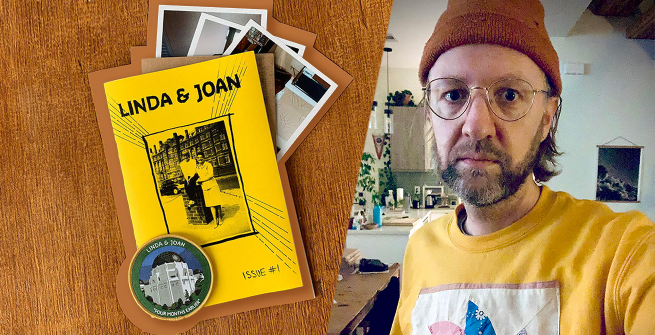Russell Quinn is an artist, designer, and programmer. He works independently as False Vacuum. Russell left the UK in 2005 and has lived in Denmark, Switzerland, and rural California. He is currently based in Los Angeles.
What is Linda & Joan Zine Club?
Linda & Joan Zine Club is an art project by me, Russell Quinn, to document artifacts and narrative fragments from my family’s history. Over the course of ten issues, a nuanced backstory will emerge, of a family connecting across generations to counter the losses and challenges they face. While the project can stand alone, it has been designed as a companion experience for Linda & Joan, a forthcoming narrative video game, also based on my family.
What is the video game Linda & Joan about?
Linda & Joan, the game, is about a British family. You play as Russell, Linda, and Joan—son, mother, and grandmother—switching between them to help the family cope with a series of traumatic events. It’s based on the year that my mother and grandmother, the two remaining members of my immediate family, died within a month of each other. The main Linda & Joan game should be out sometime in 2022, but there is a free, standalone prologue named Four Months Earlier available now.
Why did you decide to turn Linda & Joan into a zine?
I have many boxes of family photos and mementos that I inherited and brought back to Los Angeles where I now live. It's comforting to have these things, but without family members to share them with, my browsing and cataloging of them felt aimless and lonely. Making the zines adds a sense of purpose to my rummaging through boxes and sharing them with other people keeps my family's history alive somehow. Like, I’m no longer the sole custodian of these memories.
Additionally, I’m working on the Linda & Joan game by myself, which is also a rather lonely process, so making something printed and tangible that can connect me to other people feels like a necessary analog companion to an otherwise digital project.
How did you get interested in zines?
I read music zines back in England as a teenager, then for a while, I volunteered at the Here Gallery and Bookshop in Bristol. I ran the small shop on Sundays and between customers, I got to pore over the books and zines we sold. I discovered a lot of great things. Later, I worked at McSweeney’s Publishing in San Francisco and co-created a series of one-off interactive novels. So, I’ve always been interested in print and publishing and how technology intersects with a handmade, more humanistic world.
What do you think are the future of zines?
It’s exciting to see new generations of zine-makers and zines covering more diverse topics. I think people expected the internet to supplant zines. After all, anyone can cheaply share their ideas far and wide now. Earlier internet culture—homepages, LiveJournal, even Tumblr—all felt very zine-y in spirit to me. But as the internet becomes more homogenized and combative, zines seem to be booming again with the modern benefit that zine makers and readers can find each other more easily.
Issues 1 and 2 are now available for library patrons to borrow. What do you think about that?
It’s great to have these fragments of my family’s history in libraries around Los Angeles! Every new reader that learns just a little about us, keeps the memories alive. There will be eight more issues released between now and the launch of the game.
Check here for more details about the Linda & Joan project.

